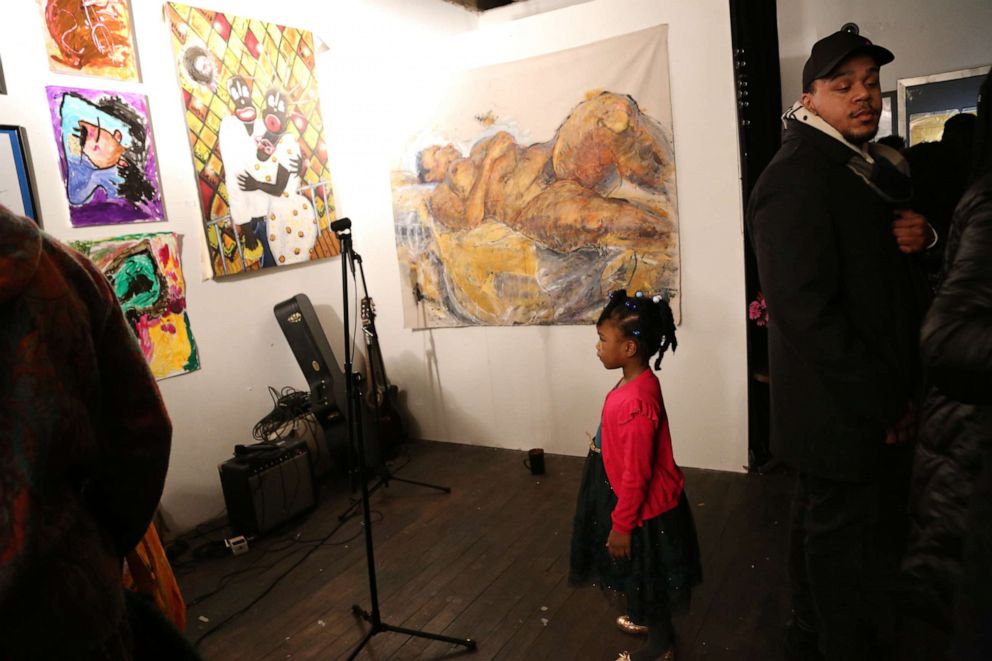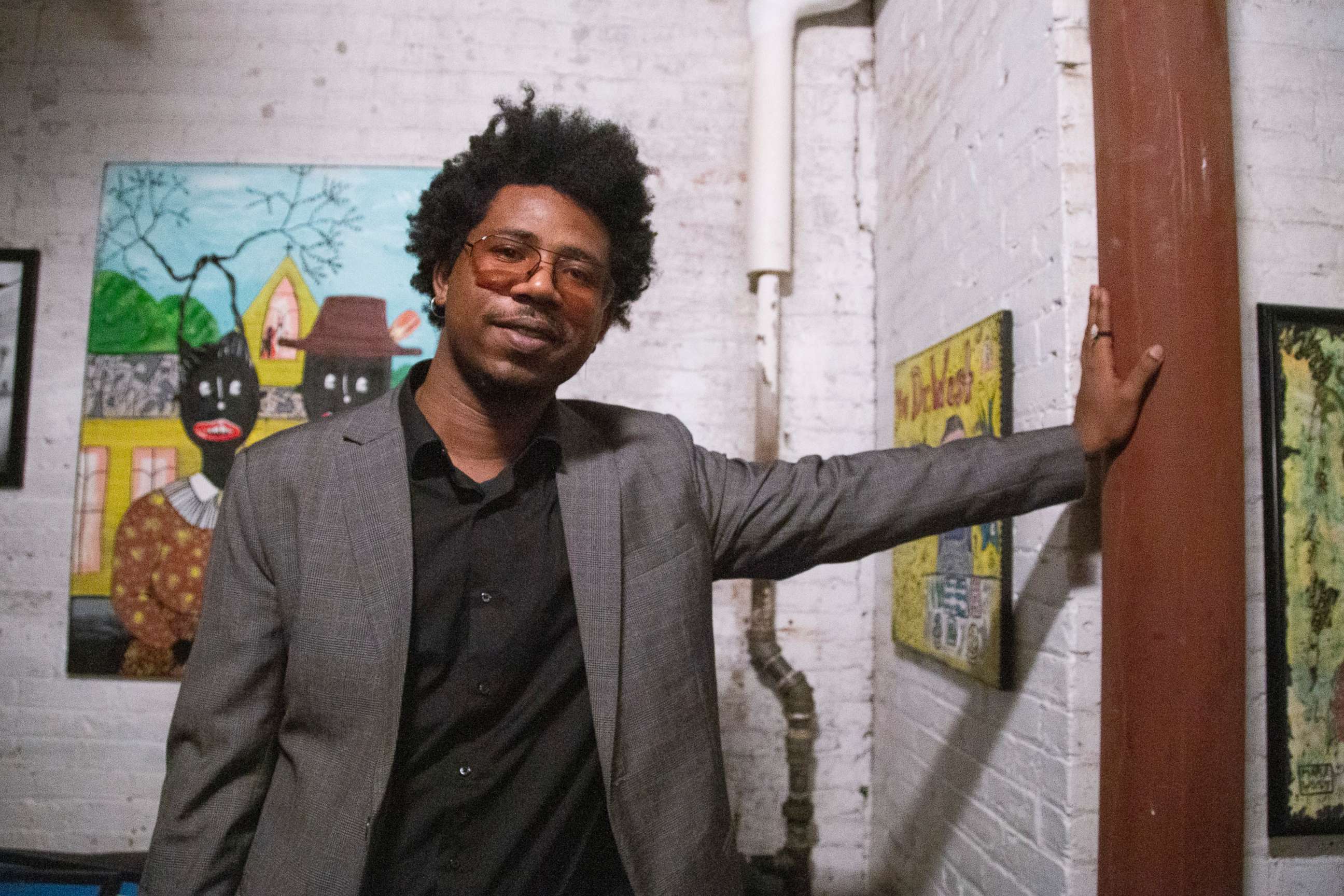Lack of representation prompts African American artist to open Bronx gallery
The goal of Mark West's gallery is to offer a space for black and brown artists.
At age 24, Mark West is one of the youngest artists -- if not the youngest -- to open an art gallery in the Bronx.
As an African American gay male, West has become a springboard for other local African American artists -- especially those who identify as LGTBQ -- who often feel they lack a platform.
This weekend, the House of Mark West Gallery hosted "Celebrating Black Voices," an exhibition showcasing African American artwork, dance, poetry and music.
"Being here really means a lot to me because growing up as an African kid in a European space we only saw American artists," said performer Shishani Vranckx, a Namibian artist raised in the Netherlands. "We didn’t know about African stars."
Vranckx teared up Saturday night before singing her song "Minority," which has been nominated for two awards at the Namibian Annual Music Awards.
"As a queer person of color ... you have to justify your existence everywhere you go," Vranckx said. "Being in this space, I am getting emotional being here with you guys, to be in this space."
"If I cry, just let me cry," she added.
For West, it’s about creating a truly safe space without exclusion, a space he doesn’t see available specifically for black artists in the Bronx.

"We want to offer emerging artists proper visibility," West said. "There is currently no space for these people to go."
For West, the gallery model has for too long involved black and brown artists looking for attention from whites.
"The new narrative is we can get support from our own communities," West said. "We can lift our own selves up. We can create our own content. We can produce our own film, open our own galleries."
After graduating from New York University with a liberal arts degree, West cycled through seven jobs in two years before landing a $60,000 position in corporate finance. In the hours he didn't spend in his cubicle, West poured himself into painting. His friends took notice and encouraged him to pursue it full-time.
West was hesitant, but decided to set up some of his paintings along 14th Street to see the public's reaction. He sold two paintings on the first day. The next weekend West sold nine pieces, earning enough money to cover his entire month's rent.
"I realized in the moment, 'I never have to apply for a cubicle again,'" West said. He quit his finance job six months later, after earning enough side money to start a small gallery.
West's Long Island Gallery opened in May 2019, and by its second packed show, guest artists were selling their paintings. West quickly realized his gallery wasn't only a space for his work, but a place to uplift the experiences and expression of all black voices. Seeing a need for such a space specifically in the Bronx, West moved his gallery in October.
The art that covered the walls of West's 500-square-foot gallery Saturday night ranged from surrealism to modernism to photography, all created primarily by local black or brown artists. Although widely different in style and medium, all the art had one thing in common: It was created by artists who had finally found a place to belong.

"Not to emphasize the pun, but it feels really surreal," Christian Santiago said, gazing at his 3.5-by-3-foot surrealism painting.
It was the first time a gallery had showcased his art.
"I never felt like I would do something like this," he said. "It's very rewarding."
Five-year-old Princess Prince, the gallery's youngest artist, has been creating art since she was 2. It was also the first time her art had been displayed in a gallery. She wore her favorite pink sweater for the occasion.
"I’m going to be famous today," Princess told her mother, Liz Lanette, on their way up the four flights of stairs to the gallery’s door.
Three weeks earlier, her father had showcased his art in the same gallery for the first time.
"It’s both of our first professional debuts," said Tashan Prince, who'd graduated from Lehman College in 2019 with a degree in fine arts.
"Her art, they’re things you could see at the Met or MOMA. I went to art school and have an eye. I’m not just saying that because I’m her dad. I’m proud of her, really proud," he said.
Creating spaces for black and brown artists to connect is Mark West Gallery’s ultimate goal.
"That’s the first thing I say with every event we have is, 'Please connect with someone next to you. Don’t leave here not knowing someone,'" said Kamara J. Hodge, the co-founder of K&B Productions, a production company working alongside the House of Mark West.
“We want people to leave with one friend or Insta buddy," said co-founder, Brandon Smith.
Their first-ever short film, "Bill and Robert," following the lives of two black, gay men in 1967, had its debut Friday evening.
At the end of each act, audience members pulled out their phones as artists shared their Instagram handles and website addresses. At the end of the evening, attendees stood chatting and exchanging contact details for an hour after the event.

"More often than not I’m the one person of color in the room," said Sheree V. Campbell, describing her typical experience as a woman of color who's worked nine years in production and entertainment. “Places like this, they give a platform for us artists to bring our work to light ... we need more platforms like this where we all just lift each other up.”
Venus Air, a nonconforming, black, improv artist, glanced around the room and asked the audience: “Do you know who your brothers and your sisters are today?”
Leaning into each other's arms, glancing behind and in front of them, audience members nodded in collective understanding. “Victory is won when we’re not alone,” Venus Air said.
“I can’t even explain how much I needed last night, and I didn’t even know,” Angie Swan, a black female guitarist who’s played with with Fifth Harmony, Adam Lambert, and currently plays for David Byrne, said the day after the event. “To be in a space with so many fellow black artists was so cathartic and necessary.”
From the moment artists enter his gallery to the moment they leave, West says his message is the same: “You are welcome here, you are accepted, you are home.”






